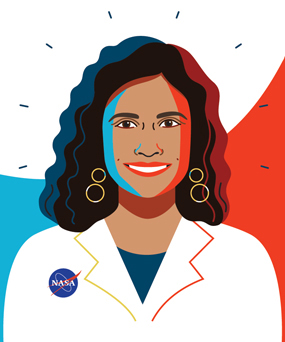
There are moments during her free time when Vandi Verma, CAS/MS ’96, sees Mars as a speck in the sky and remebers that it is, on average, 140 million miles from Earth.
Those are important reminders of her work’s enormity, because for the most part, she knows the Red Planet up close: in divots and rocks, feet and inches. The chief robotic operations engineer for the Mars 2020 Perseverance. rover and deputy section manager for mobility and robotics systems at NASA’s Jet Propulsion Laboratory (JPL), Verma has driven on Mars for 13 years, —a tenure that spans four rovers.
“One of my favorite things is looking at images of new tracks,” she says. “You can see the undulations and terrain and know nobody else has driven there.”
A decorated career in space robotics might may have recalibrated Verma’s sense of time—Perseverance is now collecting samples that will be analyzed in the 2030s—but by no means her capacity for wonder.
1973: Born in Jamnagar, India, where her father was stationed in the Indian Air Force.
1979: Received several books for her birthday, including one on the solar system that featured Laika, the first dog to reach space. “It seems so trivial when you’re older, but I was mesmerized.”
1980: Drove her first vehicle—a tractor—while summering at her grandparents’ farm. “You can’t really run over anything in a field.”
1985: Won a school embroidery contest. “I was fascinated with artistic skills people had; even today I know there’s quite a bit of art to science.”
1988: Specialized in mathematics and science for the latter half of high school. “I loved history and language, but the Indian education system makes you pick, and I was more interested in the applied aspect of math.”
1990: Enrolled at the Punjab College of Engineering, not far from her father’s post in Halwara, majoring in electrical engineering. “My mom’s very protective, so she wanted me to be close.”
1994: Packed two suitcases and moved to the United States, where she had earned a scholarship to study computer science at AU.
1997: Read about the Sojourner rover’s landing on Mars in the Washington Post. “It’s funny that I know many of those people now.”
Applied—with encouragement from AU professor Michael Gray—and was accepted to the Robotics Institute at Carnegie Mellon University.
1998: Earned her private pilot’s license.
2000: Served as a TA for a machine learning class taught by Sebastian Thrun, who later founded Google’s autonomous vehicle project.
2002: Earned her master’s in robotics from CMU. She finished her doctorate, also in robotics, three years later.
2004: Slept in a tent in the Chilean high desert while testing the solar-powered Hyperion rover as part of CMU’s Life in the Atacama project.
Joined NASA’s Ames Research Center as a research scientist. “It was pretty seamless because I had spent two summers working there. I was excited to work on real solutions for NASA.”
2007: Transitioned to JPL, her scientific home of 15 years. “It’s the place to be if you are someone who works on robotics and space.”
2008: Guided Opportunity out of Victoria Crater. “I still remember this dramatic image of the tracks with the full crater behind them.”
2011: Appeared in an episode of NOVA ScienceNOW entitled “Can We Make it to Mars?”
Became a US citizen.
2013: Hiked the High Sierra Trail with colleagues at the end of Mars time—continuous schedule adjustments to account for the longer Martian day, or sol—for the Curiosity rover mission.
2015: Married her husband, Stephen, a JPL systems engineer and fellow rover driver.
2016: Started writing software for the Perseverance rover, including arm-to-body collision detection, while still driving Curiosity. “Knowing the gory details of the small things happening in the background gives you an appreciation for how many people play a hand in each project.”
2018: Rose to supervisor within JPL’s Operable Robotics Group.
2020: Began leading 150 JPL roboticists as assistant section manager for mobility and robotic systems.
2021: Ate lucky peanuts, a JPL tradition, in the control room for Perseverance’s successful landing.
“By the time we get the signal that it’s landed, it has already happened. [For the last few minutes] there’s nothing anyone in that room can do to alter the outcome.”
Lived on Mars time with kids—twin toddlers Arjun and Anya—for the first time.
2022: Tested new software for Perseverance while serving on review boards for upcoming NASA missions.
“What keeps me excited is that we’re just on Mars. There are missions we have to Titan, Europa, outer planets, and beyond the solar system. It’s just the beginning, and there’s so much more to come.”